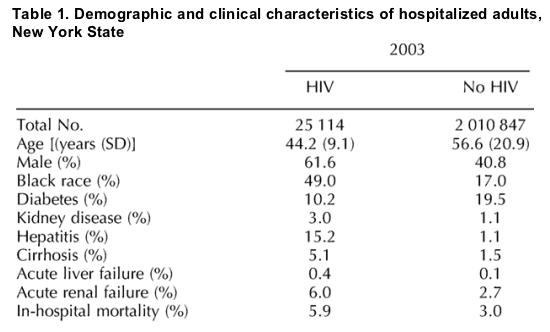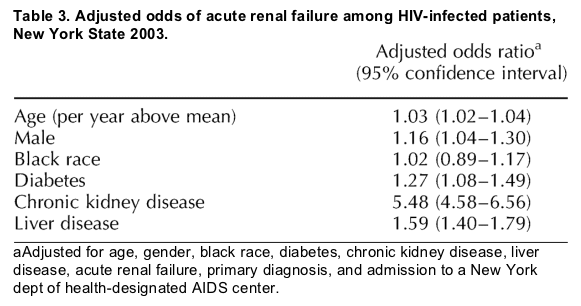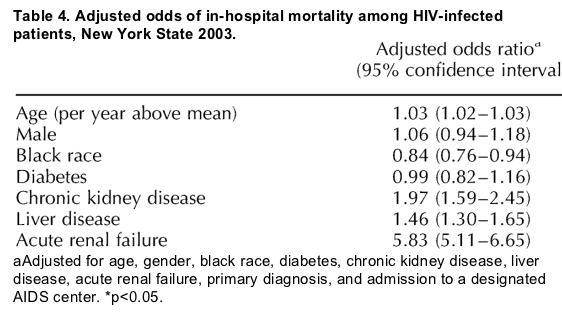| |
Kidney, liver, and cardiac disease overtaking opportunistic infections as leading causes of death among HIV-infected patients in the United States
|
| |
| |
Kidney & Liver Disease in HIV Associated with In-Hospital Mortality
"Acute renal failure in HIV is associated with chronic kidney disease, liver disease, and increased mortality"
......chronic kidney disease and acute or chronic liver disease were strongly associated with both acute renal failure and in-hospital mortality among patients with HIV, suggesting a need for more aggressive management of chronic kidney disease and hepatitis virus coinfection in the setting of HIV...... These data highlight the need to identify chronic kidney disease and hepatitis virus coinfection in the setting of HIV and to treat them aggressively.....
.... Kidney, liver, and cardiac disease have emerged as important complications in HAART-treated patients, overtaking opportunistic infections as leading causes of death among HIV-infected patients in the United States.... After adjusting for demographics, comorbid conditions, primary diagnosis, and admission to a designated AIDS center, HIV infection remained associated with an increased risk of acute renal failure both in 2003..... Among HIV-infected patients, acute renal failure was associated with traditional risk factors for renal disease, including older age, black race, diabetes, and preexisting chronic kidney disease.....Older age, male gender, diabetes, chronic kidney disease, and liver disease remained associated with acute renal failure in the adjusted analysis.... Chronic kidney disease (OR, 1.97; 95% CI, 1.59-2.45) and acute or chronic liver disease (OR, 1.46; 95% CI, 1.30-1.65) were also independently associated with increased in-hospital mortality for HIV-positive patients in the adjusted analysis....
"Acute renal failure in hospitalized patients with HIV: risk factors and impact on in-hospital mortality"
AIDS: Volume 20(4) 28 February 2006 p 561-565
Wyatt, Christina Ma; Arons, Raymond Rc; Klotman, Paul Ea; Klotman, Mary Eb
From the aDivision of Nephrology
bDivision of Infectious Diseases, Department of Medicine, Mount Sinai Medical Center
cMailman School of Public Health, Columbia University, New York, USA.
Abstract
Background: Kidney disease is an increasingly important complication of HIV.
Objectives: To examine the incidence and predictors of acute renal failure before and after the introduction of HAART, and the impact of acute renal failure on in-hospital mortality in the post-HAART era.
Methods: Adults hospitalized in acute care hospitals in New York State during 1995 (pre-HAART) or 2003 (post-HAART) were identified from the state Planning and Research Cooperative System database. HIV status was defined by primary or secondary diagnosis code. The impact of HIV and HAART on the incidence of acute renal failure and mortality, and the impact of acute renal failure on mortality, was assessed using x 2 analysis and multivariate regression.
Results:
There were 52 580 HIV-infected patients discharged from hospital in 1995 and 25 114 in 2003.
Compared with uninfected patients, HIV-infected patients had an increased incidence of acute renal failure in both the pre-HAART [adjusted odds ratio (OR), 4.62; 95% confidence interval (CI), 4.30-4.95] and post-HAART eras (adjusted OR, 2.82; 95% CI, 2.66-2.99).
In the post-HAART cohort, acute renal failure was associated with traditional predictors such as age, diabetes mellitus, and chronic kidney disease, as well as acute or chronic liver failure or hepatitis coinfection (P < 0.001 for all comparisons). Acute renal failure was associated with mortality among HIV-infected patients in the post-HAART era (OR, 5.83; 95% CI, 5.11-6.65).
Conclusions: Acute renal failure remains common among hospitalized patients with HIV and is associated with chronic kidney disease, liver disease, and increased mortality.
Introduction
The introduction of HAART at the end of 1995 dramatically altered the course of HIV infection in communities with access to therapy, significantly reducing mortality and progression to AIDS [1-5]. Kidney, liver, and cardiac disease have emerged as important complications in HAART-treated patients, overtaking opportunistic infections as leading causes of death among HIV-infected patients in the United States [6]. Patients with HIV are at risk for kidney disease related to HIV-associated nephropathy or immune complex disease [7-10], thrombotic microangiopathy [11-13], hepatitis B or C virus-related kidney disease [10,14-16], and medication toxicity [17-19].
Acute renal failure is a common complication in ambulatory HIV-infected patients treated with HAART and has recently been associated with AIDS, hepatitis C virus coinfection, and liver disease [20]. Patients hospitalized with complications of HIV may also be at increased risk for acute renal failure related to volume depletion, hemodynamic stress, and the acute administration of nephrotoxic medications or radiocontrast. Acute renal failure is a strong predictor of in-hospital morbidity and mortality in the general population [21], and retrospective data from early in the AIDS epidemic suggest that the development of acute tubular necrosis is also predictive of mortality in HIV-infected patients [22-23]. The purpose of this study was to compare the incidence of acute renal failure in HIV-positive individuals before and after the introduction of HAART, and to describe the impact of acute renal failure on mortality in the HAART era.
RESULTS
Patient characteristics in 2003
During the 2003 calendar year, there were 2 035 961 adult hospital discharges in New York State, including 25 114 for patients with documented HIV infection. Baseline characteristics of patients with and without HIV infection are summarized in Table 1. Patients with HIV infection were significantly younger (44.2 versus 56.6 years; P < 0.001) and were more likely to be male (61.6 versus 40.8%; P < 0.001) and to report their race as black (49.0 versus 17.0%; P < 0.001). While comorbid diabetes mellitus was reported less often in patients with HIV infection, chronic kidney disease was significantly more common in HIV-infected patients. Viral hepatitis, cirrhosis, and acute hepatic failure were also reported more frequently in the setting of HIV infection, with a cumulative incidence of liver disease of 20.7% compared with 2.7% in patients without documented HIV infection (P < 0.001).

Patient characteristics in 1995
Among 2 061 084 adult hospital discharges in 1995, there were 52 580 for patients with documented HIV infection. Similar to comparisons with uninfected patients in 2003, HIV-infected patients were significantly younger, more likely to be male, and more likely to report their race as black (Table 1; P < 0.001 for all pairwise comparisons). The pattern of comorbidity was also similar in 1995, with less diabetes and more chronic kidney disease and liver disease among HIV-infected patients compared with uninfected patients. Among patients with HIV, significantly fewer hospitalizations were complicated by comorbid diabetes (4.4 versus 10.2%; P < 0.001) and liver disease (8.6 versus 20.7%; P < 0.001) in 1995 compared with 2003.
HIV infection as a predictor of acute renal failure and in-hospital mortality
Acute renal failure was reported significantly more often during hospitalizations for HIV-infected patients than for uninfected patients in both 2003 (6.0% versus 2.7%) and 1995 (2.9 versus 1.0%). Renal replacement therapy was prescribed in only 1% of discharges among patients with HIV in 2003, and in < 1% in 1995. After adjusting for demographics, comorbid conditions, primary diagnosis, and admission to a designated AIDS center, HIV infection remained associated with an increased risk of acute renal failure both in 2003 [odds ratio (OR), 2.82; 95% confidence interval (CI), 2.66-2.99] and in 1995 (OR, 4.62; 95% CI, 4.30-4.95). HIV infection was also associated with an increased adjusted risk of in-hospital mortality, both in 2003 (adjusted OR, 2.96; 95% CI, 2.79-3.14) and in 1995 (adjusted OR, 6.74; 95% CI, 6.48-7.01). In patients with HIV, acute renal failure was more common in 2003 than in 1995 (adjusted OR, 2.02; 95% CI, 1.86-2.18), while in-hospital mortality was predictably lower in the HAART era (adjusted OR, 0.49; 95% CI, 0.46-0.52).
Acute renal failure as a predictor of mortality in patients with HIV in the HAART era
Table 2 summarizes patient characteristics in 2003 for the 1516 hospitalizations complicated by acute renal failure among patients with HIV infection compared with those with no documented acute renal failure. Among HIV-infected patients, acute renal failure was associated with traditional risk factors for renal disease, including older age, black race, diabetes, and preexisting chronic kidney disease. In addition, hepatitis coinfection, cirrhosis, and acute hepatic failure were more commonly reported in hospitalizations complicated by acute renal failure (P < 0.001 for all comparisons in univariate analysis). Older age, male gender, diabetes, chronic kidney disease, and liver disease remained associated with acute renal failure in the adjusted analysis (Table 3).

Hospitalizations of HIV-infected patients that were complicated by acute renal failure were also complicated by much higher in-hospital mortality (27%) than seen in admissions of HIV-infected patients without acute renal failure (4.5%). After adjusting for demographics, comorbid conditions, primary diagnosis, and admission to a designated AIDS center, acute renal failure was associated with a nearly sixfold increase in in-hospital mortality among HIV-infected patients in 2003 (OR, 5.83; 95% CI, 5.11-6.65). Chronic kidney disease (OR, 1.97; 95% CI, 1.59-2.45) and acute or chronic liver disease (OR, 1.46; 95% CI, 1.30-1.65) were also independently associated with increased in-hospital mortality for HIV-positive patients in the adjusted analysis (Table 4).

Discussion
The development of acute renal failure is a strong predictor of mortality in hospitalized patients [21], and kidney disease has emerged as a leading cause of death among HIV-infected patients in the HAART era [6]. This study compared the incidence and predictors of acute renal failure and mortality before and after the widespread introduction of HAART, and described the impact of acute renal failure on mortality in a contemporary cohort of patients with HIV infection who were hospitalized in New York State. HIV infection was associated with an increased risk of acute renal failure and in-hospital mortality both before and after the widespread introduction of HAART. Among patients with HIV infection, acute renal failure was a strong predictor of in-hospital mortality in the HAART era. In addition, chronic kidney disease and acute or chronic liver disease were strongly associated with both acute renal failure and in-hospital mortality among patients with HIV, suggesting a need for more aggressive management of chronic kidney disease and hepatitis virus coinfection in the setting of HIV.
These findings must be interpreted in light of the limitations of an observational database. The diagnosis of acute renal failure was based on the clinical judgment and documentation of the treating physician, and laboratory data were not reported. Databases similar to the one used in this study have been shown to have high specificity but poor sensitivity for non-primary diagnoses and procedures [24]. These databases are generally more sensitive for active conditions than for chronic comorbid conditions, but they may underestimate the incidence of acute renal failure as well as the burden of medical comorbidity. This type of misclassification bias typically results in diluted OR values rather than type I errors. In the absence of laboratory data or specific indications for the initiation of renal replacement therapy, it is also possible that acute renal failure was a marker of systemic disease and multiorgan failure. Further studies are needed to determine whether acute renal failure is an independent predictor of outcomes or merely an indicator of more critical illness. In addition, it was not possible to account fully for severity of HIV infection in the absence of parameters such as HIV viral load or CD4 cell count. Primary diagnosis was included in the adjusted analyses as an indication of whether the current admission was HIV related. Hospitalized patients with HIV infection may be more likely to have advanced disease; however, the results of this study are consistent with those recently reported by Franceschini et al. [20] in ambulatory patients with HIV infection.
The unexpected increase in incidence of reported acute renal failure in the HAART era may reflect a combination of factors related and unrelated to HIV. Because the incidence of reported acute renal failure increased among both HIV-infected patients and uninfected patients, it is possible that the apparent increase reflects differences in recognition and reporting of acute renal failure, or an increase in the acuity of hospital admissions in the later period. Nonetheless, the consistency between our results and those recently reported in ambulatory patients with HIV [20] suggests a true increase in the incidence of acute renal failure in the HAART era. This study attempted to adjust for the increasing burden of diabetes and liver disease in patients with HIV, but it is possible that both comorbid disease and medication nephrotoxicity play a more important role in the HAART era. Given the increasing prevalence of HIV-related end-stage renal disease and the continued growth of the HIV epidemic among susceptible African-Americans, it is projected that the prevalence of HIV-associated nephropathy will continue to increase in the United States [25]. Because the diagnosis of underlying chronic kidney disease was based on physician recognition and reporting, it is likely that the prevalence of chronic kidney disease is underestimated in this database owing to the more indolent course of HIV-associated nephropathy in the HAART era. An increase in the prevalence of unrecognized chronic kidney disease could also predispose HIV-infected patients to acute renal failure. The SPARCS database does not include information on chronic medication use, but future studies should also investigate the potential impact of HAART or specific antiretroviral medications on the incidence of acute renal failure and chronic kidney disease in HIV-infected patients.
The results of this cohort study suggest that acute renal failure remains a common complication among hospitalized patients with HIV in the HAART era. Acute renal failure in patients with HIV is associated with traditional risk factors such as diabetes, advanced age, and chronic kidney disease, as well as both acute and chronic liver disease or hepatitis coinfection. With improved survival in the HAART era, chronic kidney and liver disease have emerged as important complications in patients with HIV [6]. These data highlight the need to identify chronic kidney disease and hepatitis virus coinfection in the setting of HIV and to treat them aggressively. In addition, these results suggest that acute renal failure remains a strong predictor of mortality in the HAART era. Further prospective studies are needed to determine whether acute renal failure is an independent predictor of in-hospital mortality, or a marker of more critical systemic illness. In addition, future studies should investigate the impact of HAART or specific antiretroviral agents on the incidence of acute and chronic kidney disease in patients with HIV.
|
|
| |
| |
|
|
|